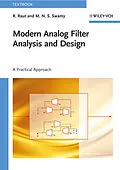Starting from the fundamentals, the present book describes methods of designing analog electronic filters and illustrates these methods by providing numerical and circuit simulation programs. The subject matters comprise many concepts and techniques that are not available in other text books on the market. To name a few - principle of transposition and its application in directly realizing current mode filters from well known voltage mode filters; an insight into the technological aspect of integrated circuit components used to implement an integrated circuit filter; a careful blending of basic theory, numerical verification (using MATLAB) and illustration of the actual circuit behaviour using circuit simulation program (SPICE); illustration of few design cases using CMOS and BiCMOS technological processes.
Autorentext
Rabindranath Raut obtained his M.Tech. degree in radiophysics and electronics from the University of Kolkata, India, in 1968, and his Ph.D. degree in electrical engineering from Concordia University, Montreal, Canada, in 1984. While in India, he worked as an electronics engineer (1968-1972) at the Indian Space Research Organization, and as a lecturer (1972-1978) in the Indian Institute of Technology. From 1983 to 1991, he worked as a senior radio-frequency electronic circuit and senior radio-frequency integrated circuit design engineer in various organizations in Canada. In 1991, Dr. Raut joined the faculty of the Electrical and Computer Engineering Department at Concordia University, where he still teaches. He has published numerous articles in various international journals and conference proceedings. He is a senior member of the IEEE (USA), and a licensed professional engineer in the provinces of Quebec (OIQ) and Ontario (PEO), Canada. Dr. Raut?s teaching and research interests lie in the areas of electronics and analog VLSI, with a specialization in analog filters and radio frequency circuits and systems.
M.N.S. Swamy received his Ph.D. degree in electrical engineering from the University of Saskatchewan, Canada, in 1963. He is presently a Research Professor and the Director of the Center for Signal Processing and Communications in the Department of Electrical and Computer Engineering at Concordia University, Montreal, Canada, where he served as the Founding Chair of the Department of Electrical Engineering from 1970 to 1977, and Dean of Engineering and Computer Science from 1977 to 1993. Since 2001, he has been holding the Concordia Research Chair in Signal Processing. Dr. Swamy has also taught in the Electrical Engineering Department of the Technical University of Nova Scotia, Halifax, and the University of Calgary, as well as in the Department of Mathematics at the University of Saskatchewan. He is the author or co-author of many articles and several books, and a Fellow of many societies including the IEEE , the IET (UK) and the EIC (Canada). He is the recipient of many awards including the IEEE-CAS Society education Medal, Golden Jubilee Medal, and the Guillemin-Cauer best paper award. He was the president of the CAS-Society in 2004 and Editor-in Chief of the IEEE transactions on Circuits and Systems during 1999-2001. Recently, he was awarded the title of Honorary Professor by the National Chiao Tung University, Taiwan.
Inhalt
Preface XV
Abbreviations XIX
1 Introduction 1
2 A Review of Network Analysis Techniques 7
2.1 Transformed Impedances 7
2.2 Nodal Analysis 9
2.3 Loop (Mesh) Analysis 9
2.4 Network Functions 11
2.5 One-Port and Two-Port Networks 12
2.5.1 One-Port Networks 12
2.5.2 Two-Port Networks 13
2.5.2.1 Admittance Matrix Parameters 13
2.5.2.2 Impedance Matrix Parameters 14
2.5.2.3 Chain Parameters (Transmission Parameters) 14
2.5.2.4 Interrelationships 15
2.5.2.5 Three-Terminal Two-Port Network 16
2.5.2.6 Equivalent Networks 16
2.5.2.7 Some Commonly Used Nonreciprocal Two-Ports 16
2.6 Indefinite Admittance Matrix 18
2.6.1 Network Functions of a Multiterminal Network 20
2.7 Analysis of Constrained Networks 24
2.8 Active Building Blocks for Implementing Analog Filters 28
2.8.1 Operational Amplifier 28
2.8.2 Operational Transconductance Amplifier 30
2.8.3 Current Conveyor 31
Practice Problems 33
3 Network Theorems and Approximation of Filter Functions 41
3.1 Impedance Scaling 41
3.2 Impedance Transformation 42
3.3 Dual and Inverse Networks 44
3.3.1 Dual and Inverse One-Port Networks 44
3.3.2 Dual Two-Port Networks 45
3.4 Reversed Networks 47
3.5 Transposed Network 48
3.6 Applications to Terminated Networks 50
3.7 Frequency Scaling 52
3.8 Types of Filters 52
3.9 Magnitude Approximation 54
3.9.1 Maximally Flat Magnitude (MFM) Approximation 55
3.9.1.1 MFM Filter Transfer Function 56
3.9.2 Chebyshev (CHEB) Magnitude Approximation 60
3.9.2.1 CHEB Filter Transfer Function 63
3.9.3 Elliptic (ELLIP) Magnitude Approximation 65
3.9.4 Inverse-Chebyshev (ICHEB) Magnitude Approximation 68
3.10 Frequency Transformations 69
3.10.1 LP to HP Transformation 69
3.10.2 LP to BP Transformation 71
3.10.3 LP to BR Transformation 73
3.11 Phase Approximation 73
3.11.1 Phase Characteristics of a Transfer Function 74
3.11.2 The Case of Ideal Transmission 74
3.11.3 Constant Delay (Linear Phase) Approximation 75
3.11.4 Graphical Method to Determine the BT Filter Function 76
3.12 Delay Equalizers 77
Practice Problems 78
4 Basics of Passive Filter Design 83
4.1 Singly Terminated Networks 83
4.2 Some Properties of Reactance Functions 85
4.3 Singly Terminated Ladder Filters 88
4.4 Doubly Terminated LC Ladder Realization 92
Practice Problems 100
5 Second-Order Active-RC Filters 103
5.1 Some Basic Building Blocks using an OA 104
5.2 Standard Biquadratic Filters or Biquads 104
5.3 Realization of Single-Amplifier Biquadratic Filters 109
5.4 Positive Gain SAB Filters (Sallen and Key Structures) 111
5.4.1 Low-Pass SAB Filter 111
5.4.2 RC:CR Transformation 113
5.4.3 High-Pass Filter 115
5.4.4 Band-Pass Filter 115
5.5 Infinite-Gain Multiple Feedback SAB Filters 115
5.6 Infinite-Gain Multiple Voltage Amplifier Biquad Filters 117
5.6.1 KHN State-Variable Filter 119
5.6.2 TowThomas Biquad 121
5.6.3 FleischerTow Universal Biquad Structure 123
5.7 Sensitivity 124
5.7.1 Basic Definition and Related Expressions 124
5.7.2 Comparative Results for p and Qp Sensitivities 126
5.7.3 A Low-Sensitivity Multi-OA Biquad with Small Spread in Element Values 126
5.7.4 Sensitivity Analysis Using Network Simulation Tools 129
5.8 Effect of Frequency-Dependent Gain of the OA on the Filter Performance 130
5.8.1 Cases of Inverting, Noninverting, and Integrating Amplifiers Using an OA with Frequency-Dependent Gain 130
5.8.1.1 Inverting Amplifier 130
